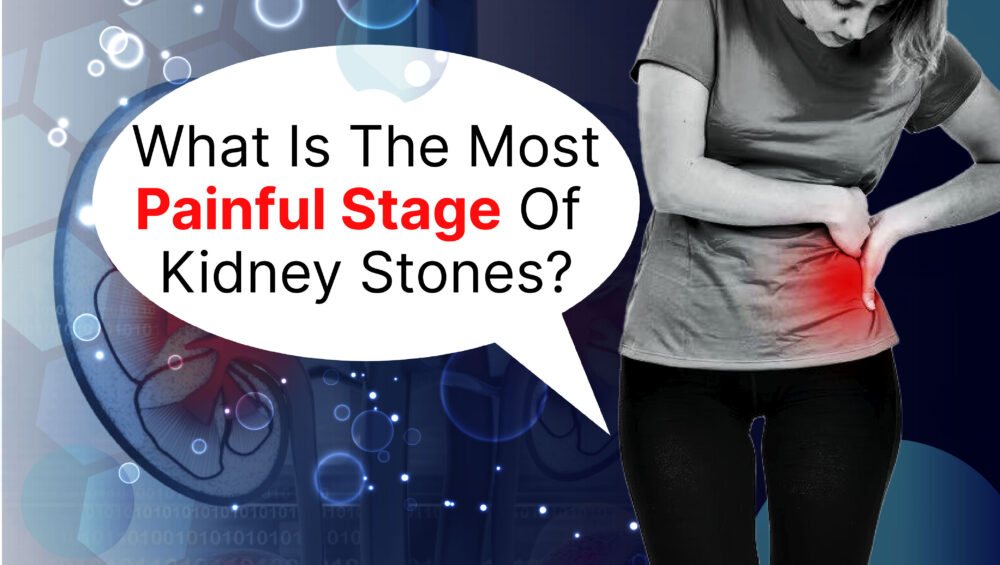Kidney stones get a bad rap because its pain is extreme, one of the most uncomfortable physical pains that a human being feels. Not every kidney stone is painful to the same degree and some of the phases can cause a person to develop extreme pain as they pass through the kidney and out through the urinary tract.
Here in this blog, we are going to look into the phases of the development of kidney stones and see which state brings the most pain and its factors and symptoms, and when to call a doctor.
What are Kidney Stones?
Kidney stones can also be referred to as hard crystalline mineral deposits that develop in kidneys upon high concentration of some substances such as calcium, oxalate, and uric acid present in urine. The size of such stones may be either grain of sand or large pebble, and they may either move down the urinary tract or stay in these kidneys.
Kidney stones are of many types:-
- Most commonly, calcium oxalate stones (Calcium oxalate stones)
- Stones of uric acid
- Infection-related Struvite stones (Struvite stones)
- Genetic stones cystine (genetic disease)
The Stages Of Both The Formation Of Kidney Stones & Their Passage
In order to figure out when the pain reaches a maximum, it is useful to divide the process of a kidney stone into different stages:
Stage 1: Development in the Kidney (No Pain or Light Pain)
At the initial stage, there is formation of small crystals by the kidneys. Individuals in this stage tend not to have symptoms. Such micro-stones can remain in the kidney with no observable effect.
You may chance to stumble over such stones without knowing it. But as long as they keep growing, they might even start creating some form of discomfort or even precondition some pain to take place in the future.
Stage 2: Mobility in the kidney
Once the stone begins to move or obstruct movement of urine along the kidney, pressure accumulates. This may make it dull or irregular pain on the side or the back. It is not the most painful phase but it is an indication that something is not right. Other individuals may experience vomiting or urinary waves (incontinence) .
Stage 3: Inside & the way through the Ureter (The Most Painful Stage)
This is the most painful stage of the kidney stone as far as the movement of the stone is concerned. Ureter is a narrow, muscular tube, connecting the kidney to the bladder. When a stone gets in this tube — particularly a 4 mm or larger one — it triggers very violent spasms, swelling, and inflammation as body attempts to pass it.
Why This Stage Is So Nagging?
- Ureteral spasms: The ureter tries to push the stone out with contractions that cause cramping pain.
- Blockage of urine flow: The pressure in the kidneys raises.
- Stretching of sensitive tissues: The lining of the urinary system has lots of nerve cells.
What type of Pain?
- Unexpected, stabbing, excruciating pain (renal colic)
- This pain is commonly felt in the side, back or lower abdomen
- May extend to the groin, testes (in males) or vulva (in females)
- Can often come in waves and can last for minutes to hours
- Can be accompanied by nausea, vomiting and sweating and inability to get comfortable position
The 4th Stage: Achieving the Bladder (Reduction of Pain)
When the stone passes over to the bladder, the pain becomes considerably attenuated. The ureter does not get stretched or obstructed anymore. This is the stage when the patient can be less complaining about the severity of the attacks of pain. But there might still be some upset of the bladder problem or need to go to urinate frequently.
Stage 5: Moving Through the Urethra
The ejection journey also may be uncomfortable but one which is not usually as painful when compared to the ureteral phase. In case it is not very large it might pass. Bigger ones may result in burning during passing the urine or the sense of not being emptied completely.
When to Get Medical Aid?
Although small stones (less than 5 mm) can usually pass without any medical help, healthcare assistance can be critical in the next case:
- When this happens, pain cannot be managed using over-the-counter drugs
- Fever or shivers (this may be a sign of infection)
- Urine in blood
- Strain upon urination or inability to urinate Freud describes these two conditions as an obstruction to going to the lavatory.
- Nausea or vomiting that does not allow fluid consumption
Treatment & Pain Management
1. Pain Relief
Medications such as NSAIDs, i.e., ibuprofen or ketorolac that alleviate the pain, are commonly used by the doctors. In a more permanent case, some temporary use of opioids will be needed.
2. Medical expulsion Therapy
Drugs such as tamsulosin are alpha blockers that make the ureter relaxed so that the stone can easily move.
3. Hydration
Water causes the amount of urine to flow out and thus pushing the stone.
4. Minimally Invasive Procedures and Surgeon
In case the stone cannot pass, it is recurrently infected or stops the urine discharge the intervention measure might be needed:
- Shock wave Lithotripsy (SWL): It is a machine that uses sound waves to crack the stone into small pieces.
- Ureteroscopy: A very small scope is advanced through the urethra in order to fragment or remove the stone.
- Percutaneous Nephrolithotomy: A type of surgery where the kidney has large stone pieces removed through key holes.
Prevention Advice for Kidney Stone Recurrence
Once you experience kidney stone, it is more likely that you can have it again. This is what you can do to reduce your risk:
- Make sure you are well hydrated (2 to 3 liters of water per day)
- Restrict high sodium and oxalate containing foods (spinach, nuts, chocolate)
- Consume less animal proteins
- Take medications under the condition of underlying metabolic problems
- Frequent monitoring and imaging are necessary, particularly in case you got frequent stones in the past
Conclusion
The most agonizing period of the kidney stones is when the stone passes out through the ureter. This can cause severe pain which might be painful to such an extent that medical attention is needed on the spot due to the amount of pressure and spasms it causes. Although kidney stones are prevalent, early diagnosis and management may help much in minimizing its pain and help one avoid complications.
In a case when you are having symptoms or have had a history of kidney stones in the past, it is important to see a specialist.
Being one of the most reliable kidney stone doctors in Gurgaon, Dr. Deepanshu Gupta has already assisted multiple patients in overcoming several painful steps on their way to living a pain-free life. Dr. Gupta has 15+ years of experience and delivers high-quality individual treatment plans regardless of the medical management or advanced surgical solutions. And in case you are experiencing the signs of kidney stone, do not wait until the pain intensifies.
Consult with Dr. Deepanshu Gupta and get the treatment started on your way to the long term relief.

